Publishers! How to optimize video ad zones with ExoClick
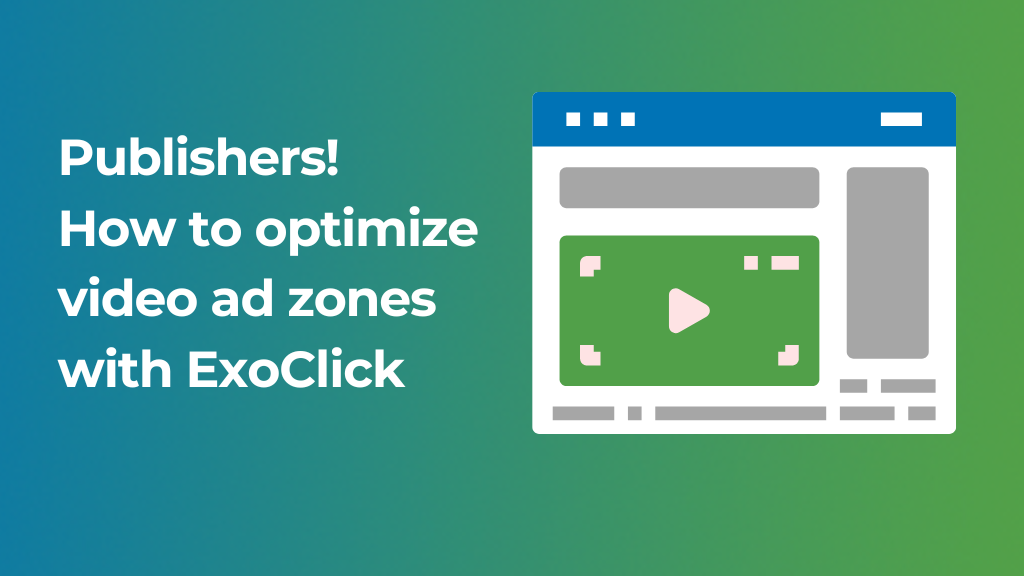
When monetizing video advertising, one of the main questions from Publishers to their ExoClick account managers is how to use the different types of video ad formats to find the perfect balance between maximizing revenues and ensuring a great end user experience. ExoClick offers Video Slider, Instream and Outstream video ads. Every Publisher site’s traffic will behave differently and when you throw desktop and mobile versions into the equation, it requires experimentation to find that ‘sweet spot.’ In this blog post we will give you some examples of how 2 Publishers are using video ad formats, tips for video ads and user experience, some best practices from our Publisher account managers and how to optimize video ad zones for your website’s video advertising. The aim is to give you great tips for how to montize video content effectively.
Generate big revenues by monetizing video advertising
Monetizing video advertising is big business and according to Statista expected spend on video ads is €205bn in 2023 and €232bn in 2024. As a publisher monetizing video content you want to ensure you get a piece of this revenue for your traffic. So why is video such a huge revenue generator?
According to a survey carried out by Wyzowl:
- 96% of marketers continue to value video as an ‘important part’ of their marketing strategy.
- 91% of businesses use video as a marketing tool in 2023
- 70% of ‘non-video marketers’ plan to start online video marketing in 2023.
- 66% of video marketers created live streamed video ads in 2022.
- 57% of video marketers created screen recorded video in 2022.
- 55% of video marketers created animated video in 2022.
- 36% of marketers created product demo videos in 2022.
- 92% say video gives them a good return on their investment.
- 89% of people say watching a video has convinced them to buy a product or service.
ExoClick’s three video ad formats: Video Slider, Instream and Outstream Video ads
Let’s look at the different formats that ExoClick’s platform provides: Video Slider, Instream and Outstream video ads for monetizing video advertising.
Video Slider: Once a website page has loaded, the end user will see the ad slide in from the bottom right of the page, which makes this format very eye-catching. It plays on mute, and the end user must unmute the ad to hear the ads audio.
Instream Video (VAST): Instream video ads will show on a publisher’s site inside a video player which the user will most likely watch in full screen mode. Once the video ad starts playing, a ‘skip ad’ button is shown to end users on the bottom right of the screen, just like Youtube ads. This video format has the highest CTR and a very high conversion rate and is very succesful for Publishers monetizing video content. It is available as:
- Pre-roll: The ad is shown before the end user can watch the video content selected
- Mid-roll: The ad is shown somewhere in the middle of the video content being watched
- Post-roll: The ad is shown at the end of the video content the end user has watched
Please note: Despite Mid-roll being used a lot on Youtube videos, it is still considered to affect user experience.
Outstream Video: This ad is shown to end users while scrolling a website. The publisher can set the timing when the video ad will be displayed on the website. As the user scrolls down the page the ad zone pushes the website content down and the Outstream ad starts being visible to the user. Once 50% of the ad zone is viewable, the video ad plays automatically on mute giving the option to the end user to unmute it.
How to optimize video ad zones: Two Publisher case studies
With Video Slider, Instream and Outstream video ads we get asked how to montize video content? How to optimize video ad zones? Lets answer those questions as we look at two different Publisher sites, one on Desktop and one on Mobile to find out how they do it. Both Publishers use all three video ad formats on their sites.
Publisher Case study 1: Desktop site
On page of this Publishers desktop site, let’s look at the end user journey:
- The page opens and the Video Slider is displayed
- The end user scrolls down the page through the video content thumbnails, where an Outstream ad is displayed
- The end user clicks on a video content thumbnail
- Three NTV banners are displayed next to the video content selected
- The end user clicks on the video and a pre-roll In-stream ad is displayed
So the Publisher is displaying 3 NTV banner ads, 1 video slider, 1 outstream and 1 in-stream ad.
Looking at percentages of the total revenue generated for the different ad zones of this end user flow/page for 7 days the split is as follows:
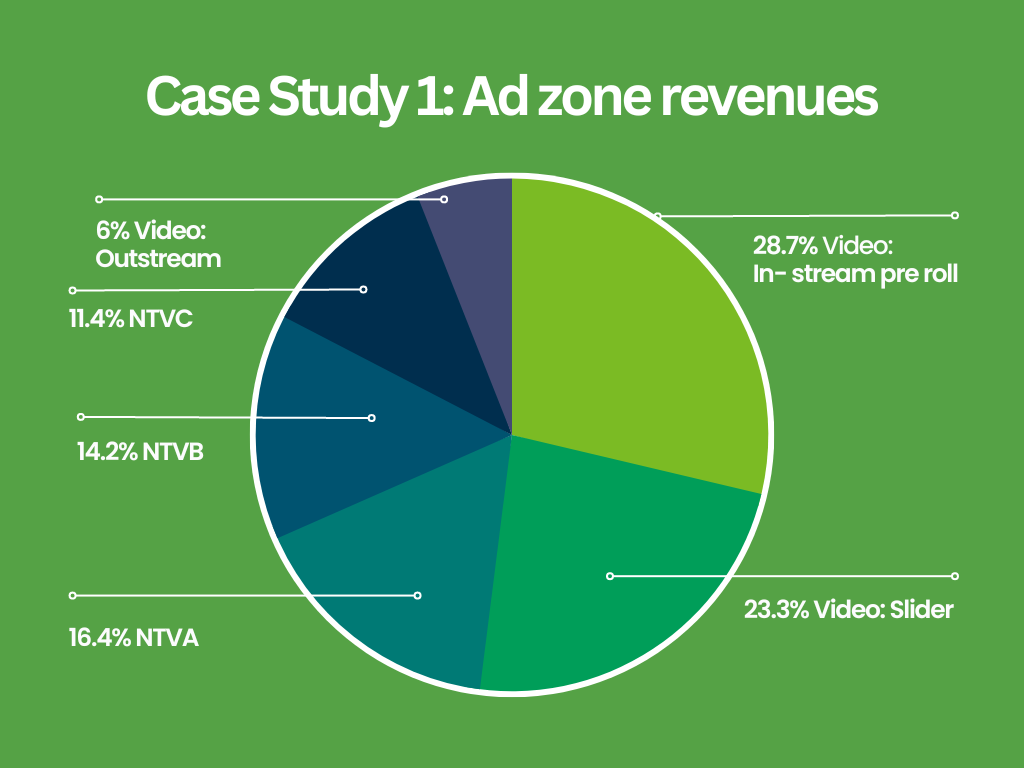
As you can see, when monetizing video advertising, for this publisher, video generates 58% of this Publisher’s revenues. Now let’s look at the video format eCPMs and CTRs compared to average eCPM and CTRs of the three banner zones, that have an average CTR of 0.28% when combined:
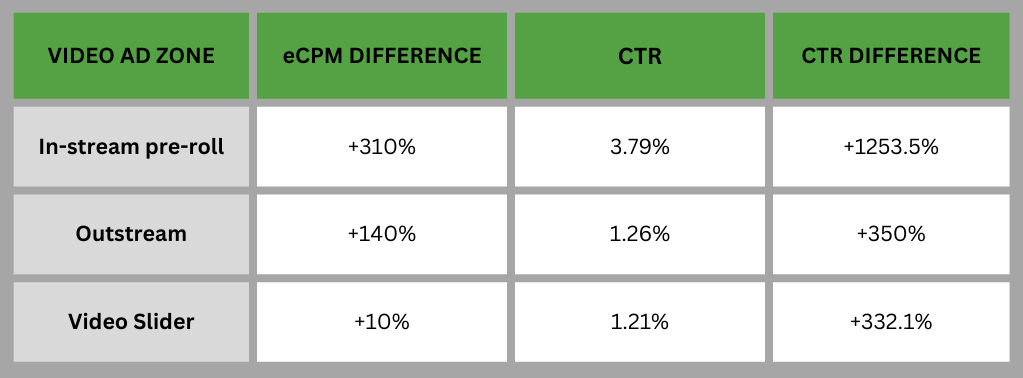
So this Publisher uses all three video formats: Video Slider, Instream and Outstream video ads. One of the ways to ensure a good end user experience is to experiment with the Frequency Capping option in the admin panel. Here are the Frequency Capping optimizations for this website on desktop:
- Outstream: Frequency Capping 0 (all video pages). Position in the middle of content only within video pages
- Instream pre-roll: Frequency Capping 15 minutes
- Slider: Frequency Capping 15 minutes (all pages)
Publisher Case study 2: Mobile site
On this mobile site, let’s look at how this Publisher is monetizing video advertising, here is the end user journey:
- The website’s page opens and the Header Banner is displayed and the Video Slider is displayed
- The end user scrolls down the page through the video content thumbnails, where an Outstream ad is displayed and a Native Middle is displayed
- The end user clicks on a video content thumbnail
- The Under Video Banner is displayed next to the video content selected
- The end user clicks on the video content and the In-Stream pre roll is displayed
- The end user watches the video until the end and the In-Stream post roll is displayed
- If the end user scrolls down the bottom of the page the Footer Banner is displayed
So the Publisher is displaying Banners: Header, Footer, Under Video, Native Middle, Video: Slider, Outstream, Instream pre roll, Instream post roll. Looking at percentages of the total revenue generated for the different ad zones of this end user flow/page for 7 days the split is as follows:
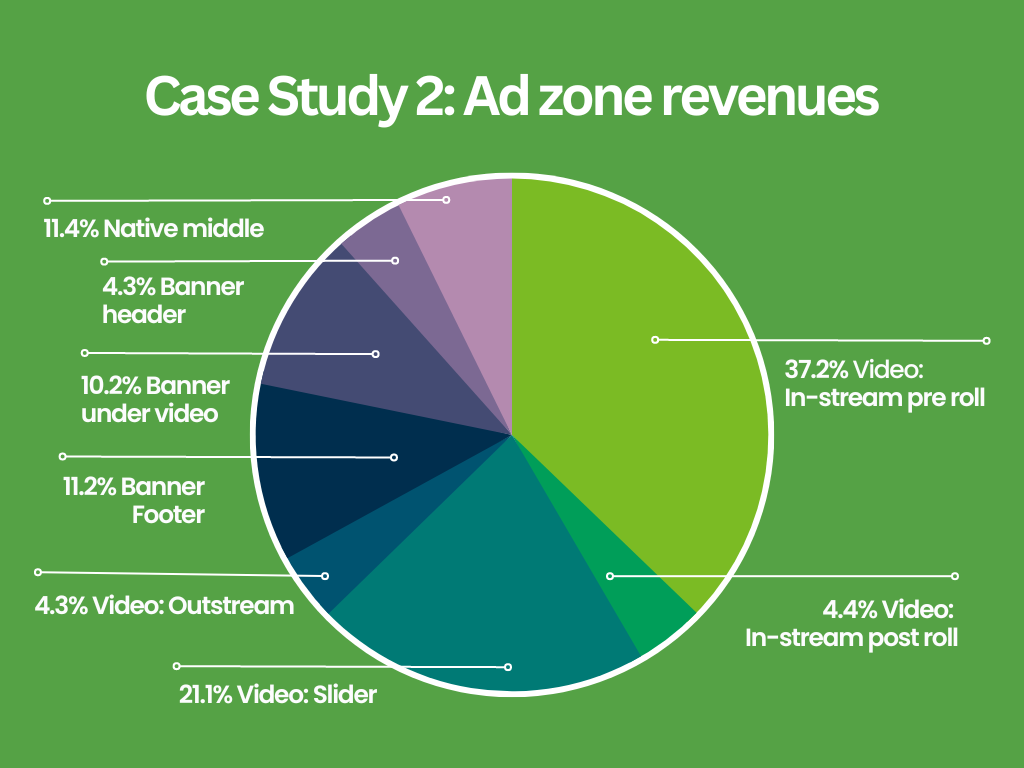
As you can see, when montizing video content, here, video generates 67% of ad revenues. Now let’s look at video eCPMs and CTRs compared to average eCPM and CTRs of the three banner zones and one native zone:
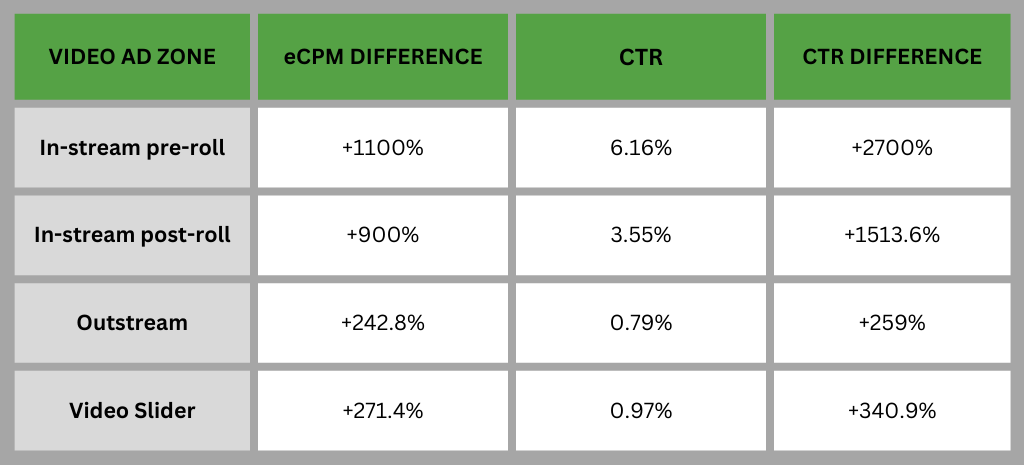
So this Publisher again uses Video Slider, Instream and Outstream video ads, and both pre-roll and post-roll for the Instream format. This publisher experimented with the Frequency Capping option in the admin panel. Here are the Frequency Capping optimizations used:
- Outstream: Frequency 0 (all video pages). Position in the middle of content only in video pages
- Instream pre-roll and post-roll: Frequency 15 minutes
- Slider: Frequency 15 minutes (all pages)
Video Slider, Instream and Outstream video ads: How to optimize video ad zones for great user experience
Video ads are generally between 15 seconds and 30 seconds duration. When monetizing video advertising, many publishers are worried about using all 3 video formats:Video Slider, Instream and Outstream video ads together, especially Oustream with Slider. With right frequency capping and positioning, all 3 video ad formats can be used in one site and be user friendly. Which bring us to the subject of this article: how to montize video content and how to optimize video ad zones. Here are some great tips for each video format:
Video Slider
This format slides in as soon as the page loads, so it will likely be the first video ad seen by end users. Therefore it offers high visibility for advertisers bidding for this zone. Additionally because it is contained within its own video player, sites are monetizing video advertising even if they don’t have video content. Here are our recommended optimization tips:
- Frequency Capping: It is not recommended to use 0 frequency. Under the admin panel option ‘Once closed, hide for:’ This is where you can edit the frequency capping and you can choose the next time you want to show the ad to each user, we recommend that you set this to 24h.
- Close Button: This sets the time in seconds that the user has to watch the ad before being able to close it. Experiment with 0 (by default) where the ads close button is shown from the start, or 5 seconds as is the industry standard for ads on Youtube.
- Screen density: This will allow you to choose what percentage of the screen is taken up by the ad zone when it is triggered. As a Publisher, this feature enables you to ensure that your Video Slider ad zones display well on all devices, especially mobile. It will also ensure that your ad zones meet common guidelines for good advertising.
- Enable our CTA Feature, which allows you to let advertisers add a predetermined CTA which results in higher user engagement. Higher engagement means more clicks which increases the CTR of the ad zone, this creates greater demand for the zone, pushing up the eCPM value. Read our Video Slider ad zone set up.
Instream
The Instream video ad format allows you to monetize your video content. It has the highest CTRs of all the video ad formats. You have the possibility of monetizing 3 ad placements: pre-roll/mid-roll/post-roll. ExoClick’s In-stream ad format works with all video players including the free open source video player Fluid Player, or paid for html video player JW Player. Fluid Player can help you obtain higher revenues because it allows you to monetize In-stream & live streaming video ads, additionally you get VAST and VPAID video metrics and you can add a custom call to action text when playing a video ad. Check out our blog post: Meet Fluid Player: The lightweight free online video player, for more information. Here are our recommended optimization tips:
- Make sure the video player that you use is VAST wrapper compatible, or disable it from the zone settings. It’s important otherwise the player cannot read those campaigns and you may lose impressions
- Frequency: We recommend setting this to “Every hour.” An hourly Frequency Capping is a great balance between end user experience and monetization. As a maximum we suggest no greater than every 15 minutes, depending on the visit length and video views per visit.
- Skip button: The industry standard is a setting of 5 seconds before the end user can skip the ad, this is generally acceptable to end users, as it is similar to Youtube.
- Post-roll or mid-roll: You can use these additional video ad placements for added revenue.
Outstream
Outstream is shown to the end user as they scroll through your website’s content. It can be placed anywhere, but we recommend that you place it within the middle of a page. This video ad plays without the need for a video player, so it is great for sites that do not have video content, but want to monetize video advertising. Outstream has some great advantages for attracting advertisers because you can place the Outstream ad zone ‘contextually.’ For example, if you have a web page dedicated to Dating site reviews, advertisers can target the ad zone with Dating offers, this brings value to the end users, because they are already checking your Dating site reviews, making this ad zone highly desirable for Dating offers and a great end user experience.
Think of Outstream as a display ad rather than a video ad. It can generate much higher revenues than banners because it has a higher eCPM value than a group of banner ads, ideally you should use Outstream as an extra display ad zone to compliment your banner ads. Check out our blog post: How does Outstream compare to Banner eCPMs & CTRs? Here are our recommended optimization tips:
- Use Outstream sparingly: For the best user experience don’t create too many ad zones or the end user will avoid them, which will affect your CTRs, you need to find the sweet spot, we recommend you only use 1 Outstream ad zone per page
- Positioning: Ideally above or below the mobile middle on mobile devices and between the content on Desktop devices. This allows the user time to interact with your site’s content first, before seeing the Outstream ad zones. If you also have a Video Slider ad zone implemented this gives the user time to see the Slider ad first when your page loads and then as the user scrolls down through your content you can start showing your Outstream ads. Please note: Outstream impressions are counted only when 50% has been revealed, therefore to earn revenues from impressions it’s recommended to place it in a visible area of the page.
- Frequency: Just like banners, you can use Outstream without Frequency Capping, that way it will show on every page.
- Customize: Use a <div> container to place the ad zone on your site. You can adjust the width in the settings that match the container, but do not force the height to 100% in the CSS or it may cause scroll issues on your site. We recommend that you select a custom size that fits in with the size of the video players you have on your site. This will make it appear more like site content to ensure a greater user experience and generate more clicks. You can choose a custom width from 200px to 1080px.
- Use our CTA Feature for higher user engagement
Conclusion of monetizing video advertising
As you can see from our case studies, both publishers useVideo Slider, Instream and Outstream video ads and they amount to the biggest share of revenues generated. I hope this has helped you to learn how to optimize video ad zones and the balance between video ads and user experience. Basically it is a case of experimenting with the great admin panel tools provided, check your statistics and fine tune. When monetizing video advertising, it is worth experimenting across different devices and GEOs. For example in a GEO like India most of the population connect to the internet via smartphones therefore to monetize Indian traffic and provide a good experience, it will be more important to optimize your video ad zones on mobile to for your Indian traffic.